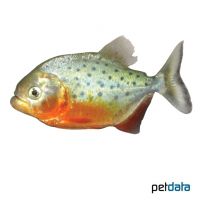Red Bellied Piranha (Pygocentrus nattereri)
| Red Bellied Piranha Pygocentrus nattereri | |
|---|---|
| Name | Red Bellied Piranha |
| Name Lat. | Pygocentrus nattereri |
| Synonym | Serrasalmus nattereri |
| Family | Piranhas & Pacus |
| Family lat. | Serrasalmidae |
| Order | Characins |
| Order lat. | Characiformes |
| Origin | South America |
| Habitat | Streams, rivers, lakes |
| Diet | Omnivore |
| pH | 5.5-7.5 |
| Behavior | Predatory |
| Keeping | Group |
| Care Level | Experts only |
| Reproduction | Egg scatterer |
| Breeding | Difficult |
| Life Span | 5-10 years |
| Protection | No |
| Metric Units | |
| Size | 25-30 cm |
| Temperature | 23-27 °C |
| Hardness | 5-15 °dH |
| Aquarium | 500 l |
| US Units | |
| Size | 10"-12" |
| Temperature | 73-81 °F |
| Hardness | 89-267 ppm |
| Aquarium | 130 gal |
Distribution and habitat
The range of the red piranha extends over the Amazon and Orinoco regions, all Guyana countries, and the Rio de la Plata, Rio Paraguay and Rio Paraná. They live in rivers, tributaries, streams, flooded forest areas, lakes and pools. They are especially common in the Pantanal, a wetland in southwestern Brazil.
Maintenance
The aquarium should have a varied, partly dense planting, with shelters and hiding places (roots) and provide sufficient swimming space. A dark substrate covered with some foliage (e.g. sea almond leaves) and shaded light (floating plants) is ideal.
No ammonia, ammonium and nitrite should be detectable, the nitrate value should not exceed 100 mg/l. To ensure water quality and oxygen content, a filter and heater adapted to the aquarium size is required, as well as lighting for the species-appropriate day-night rhythm of the animals.
Diet
In nature they feed mainly on insects, worms and fish. The food supply consists of live food, such as artemia, mosquito larvae and mysis, which is also well accepted frozen, plus commercially available frozen special food mixtures with fish, crab and mussel meat. High-quality, protein-rich dry food (food tablets, granules, pellets) is also usually accepted.
Only as much should be fed as is eaten immediately (in a maximum of 10 minutes). A regular and varied diet promotes health and increases resistance.
Behaviour and compatibility
They are shy schooling fish, mostly hiding under dense vegetation (ambush hunters). There is a strict hierarchy within the group. They can be socialized with other fish, although attacks can never be excluded, even after a longer period of living together. It is recommended to keep them in a tank of their own species. At least 5 Red Piranhas should be kept together. Only mutually compatible fish species with similar demands on water quality and water temperature may be kept together.
Sex dimorphism
There are no sure distinguishing characteristics. The male has a red throat and is silvery gold, the female is more intense yellow color.
Reproduction and breeding
Breeding has been successful only occasionally and in very large aquaria. The eggs are laid in large pits in the gravel bottom. A clutch consists of 500-1,000 eggs and is fiercely defended by the male. After 3-4 days the larvae hatch, after about 8 days the young swim free and the brood care is stopped.
Young fish must be fed several times a day with special rearing food
Important
When handling in the aquarium, caution is advised, because the animals can bite hard with their razor-sharp teeth. Normally they do not attack humans. They are only dangerous in aquariums that are too small, when they cannot avoid them and feel threatened, or during feeding
The well-being of the fish should be checked regularly. Temperature should be checked daily, pH, hardness and nitrate levels should be checked at least every 14 days. Regular partial water changes are recommended, even if the contaminant level has not yet reached the upper limit. Sudden changes in water quality should be avoided. Newly introduced fish must be accustomed slowly to the water in the aquarium.
Further literature can be found in your pet store.
References
Text: petdata; Image: petdata
Source: BMELV (1998): Tierschutzgutachten - Haltung von Zierfischen (Süßwasser); RIEHL & BAENSCH (2002): Aquarien Atlas, Mergus Verlag; ENGELMANN (2005): Zootierhaltung - Tiere in menschlicher Obhut: Fische, Zootierhaltung, Verlag Harri Deutsch
- Gemäß § 21 Abs. 5 Tierschutzgesetz idgF
